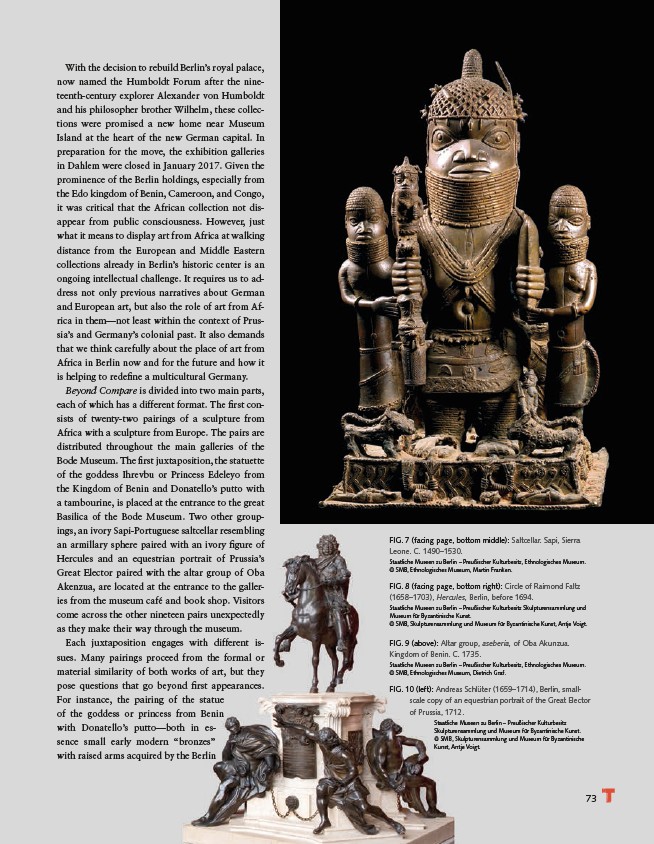
73
Scontornare mantenendo ombre
FIG. 7 (facing page, bottom middle): Saltcellar. Sapi, Sierra
Leone. C. 1490–1530.
Staatliche Museen zu Berlin – Preußischer Kulturbesitz, Ethnologisches Museum.
© SMB, Ethnologisches Museum, Martin Franken.
FIG. 8 (facing page, bottom right): Circle of Raimond Faltz
(1658–1703), Hercules, Berlin, before 1694.
Staatliche Museen zu Berlin – Preußischer Kulturbesitz Skulpturensammlung und
Museum für Byzantinische Kunst.
© SMB, Skulpturensammlung und Museum für Byzantinische Kunst, Antje Voigt.
FIG. 9 (above): Altar group, aseberia, of Oba Akunzua.
Kingdom of Benin. C. 1735.
Staatliche Museen zu Berlin – Preußischer Kulturbesitz, Ethnologisches Museum.
© SMB, Ethnologisches Museum, Dietrich Graf.
FIG. 10 (left): Andreas Schlüter (1659–1714), Berlin, smallscale
copy of an equestrian portrait of the Great Elector
of Prussia, 1712.
Staatliche Museen zu Berlin – Preußischer Kulturbesitz
Skulpturensammlung und Museum für Byzantinische Kunst.
© SMB, Skulpturensammlung und Museum für Byzantinische
Kunst, Antje Voigt.
With the decision to rebuild Berlin’s royal palace,
now named the Humboldt Forum after the nineteenth
century explorer Alexander von Humboldt
and his philosopher brother Wilhelm, these collections
were promised a new home near Museum
Island at the heart of the new German capital. In
preparation for the move, the exhibition galleries
in Dahlem were closed in January 2017. Given the
prominence of the Berlin holdings, especially from
the Edo kingdom of Benin, Cameroon, and Congo,
it was critical that the African collection not disappear
from public consciousness. However, just
what it means to display art from Africa at walking
distance from the European and Middle Eastern
collections already in Berlin’s historic center is an
ongoing intellectual challenge. It requires us to address
not only previous narratives about German
and European art, but also the role of art from Africa
in them—not least within the context of Prussia’s
and Germany’s colonial past. It also demands
that we think carefully about the place of art from
Africa in Berlin now and for the future and how it
is helping to redefine a multicultural Germany.
Beyond Compare is divided into two main parts,
each of which has a different format. The first consists
of twenty-two pairings of a sculpture from
Africa with a sculpture from Europe. The pairs are
distributed throughout the main galleries of the
Bode Museum. The first juxtaposition, the statuette
of the goddess Ihrevbu or Princess Edeleyo from
the Kingdom of Benin and Donatello’s putto with
a tambourine, is placed at the entrance to the great
Basilica of the Bode Museum. Two other groupings,
an ivory Sapi-Portuguese saltcellar resembling
an armillary sphere paired with an ivory figure of
Hercules and an equestrian portrait of Prussia’s
Great Elector paired with the altar group of Oba
Akenzua, are located at the entrance to the galleries
from the museum café and book shop. Visitors
come across the other nineteen pairs unexpectedly
as they make their way through the museum.
Each juxtaposition engages with different issues.
Many pairings proceed from the formal or
material similarity of both works of art, but they
pose questions that go beyond first appearances.
For instance, the pairing of the statue
of the goddess or princess from Benin
with Donatello’s putto—both in essence
small early modern “bronzes”
with raised arms acquired by the Berlin